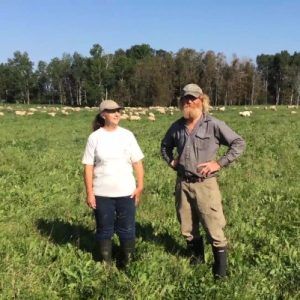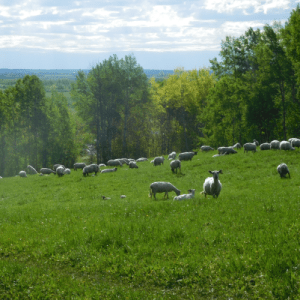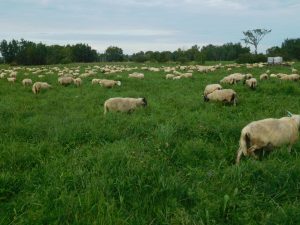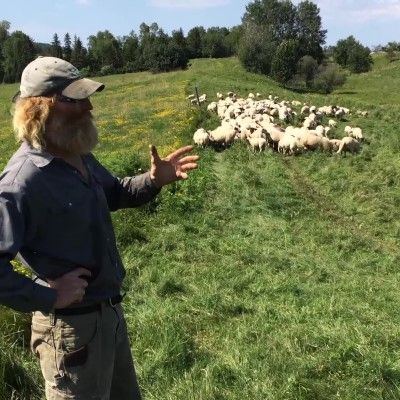
Jim Johnston and Wanda Cook operate Pasture Hill Farm just west of New Liskeard, in northeastern Ontario. They have been raising sheep and lambs since 1993, with a current flock of 650 ewes, along with a smaller herd of direct market, grass-fed beef.
*A shortened version of this article was published in the Fall 2020 edition of EFAO’s quarterly print newsletter: Ecological Farming in Ontario.
In the following, I would like to give an overview of our pasture management system for sheep and lambs. Our farm consists of Jim (me), Wanda Cook (my wife and business partner) and usually 1 summer student. We have 2 grown children who worked on our farm before moving on to their own careers outside of agriculture. Our farm is just west of New Liskeard in the Temiskaming district of northeastern Ontario. The soil is mostly clay, some tiled and some not tiled. We have been on the home farm since 1993 and have raised sheep and lambs as our primary enterprise and also direct market grass fed beef from a smaller beef herd.
Our production system:
Our sheep flock is raised outdoors year round on pasture and stored forage (dry hay and wrapped bales). We produce only forages on our own land and buy standing hay/baleage from one or more local farmers.

- Ewes lamb on pasture starting around May 20 and are mostly done lambing by June 15.
- Ewes and lambs are rotationally grazed through till weaning in mid-late October.
- After weaning, the dry ewes will stay on pasture as long as the grass is available, usually around November 15 to 20.
- Bales are rolled out on pasture until mid-December, then all groups of ewes are brought home for the winter.
- From mid-December until turnout around May 20, ewes are fed outdoors in dedicated wintering areas that have natural windbreaks.
- Rams are turned out December 26-28.
Our pasture philosophy:
Our goal on our owned land is to have permanent forage stands, meaning they are (hopefully) never ploughed and reseeded. I will describe below various management practices used to keep these old meadows productive.
When we started here in 1993, we did reseed most of the tillable land and as we purchased more land we reseeded the tillable acres on that as well. The last land we purchased and reseeded was in 2005. No land that we have reseeded has been broken since then, meaning our forage stands on tillable land are from 15 to 25 years since establishment. Our permanent pastures, which are good, productive land but limited by steep slopes or inaccessible by tractor, have been in grass for over 50 years.
How we maintain our pastures:
*In regards to the agronomic aspects of growing forages (hay and pastures), I would encourage the reader to refer to OMAFRA Publication 811 for detailed information and recommendations.
A) Non-grazing Practices:
Soil testing and fertilizer: I would encourage the use of soil testing to know what the limiting nutrients are in your particular soils. Details on how to soil test, what tests to do, and where to find an accredited lab are available from the OMAFRA website or crop advisors. It is common in our area for the clay soils to be low to very low in phosphorous (on land that has not been well fertilized or had manure over the years). This is the case for our soils. Also common on clay soils, our potassium levels are adequate to high in most cases. My own philosophy for hay and pasture fertility is to use small amounts of nitrogen to encourage the grasses but not too much as we also want to keep or promote legumes (trefoil and clovers) in the stand. We also apply relatively small amounts of phosphorous fertilizer, less than recommended by the soil test, but we plan on putting these small amounts on for a number of years until we can raise our soil test levels to the desired level. I studied pasture management under the supervision of Dr. E. Ann Clark at OAC in the 1980’s. Her saying regarding pasture improvement was “evolution, not revolution” – meaning a slow improvement over time using many tools, not just a revolution by ploughing, reseeding, and applying large amounts of fertilizer. I tend to follow this thought process myself.
Manure management: One major benefit of grazing as much as possible is that most of the manure and urine is returned directly to the soil, thus reducing the amount of equipment, fuel, and time needed to spread manure from barns, yards, and outdoor wintering areas. In our area, we try to keep our ewes on pasture until mid to late November. After the ewes pasture is all used up or the snow is too deep to graze (over about 6″ depth), we will roll bales out on pre-selected pastures until mid-December. This allows any uneaten hay plus manure and urine to be spread over the pasture, essentially fertilizing the pasture. We have made significant improvements in the productivity of our permanent pastures with this method.
Once the snow gets deep in December, we bring our ewes all home, sort them into breeding groups and assign them to various outdoor wintering areas. In these areas, we roll out bales all winter and over time build up a pack. Each wintering area has a windbreak and we will periodically bed these areas with straw and in time this builds up another pack. In spring we push these packs up into windrows with a loader. These windrows then heat and break down some before being spread in August and September.
When deciding where to haul and spread manure from the wintering areas, the temptation is to spread as close as possible to the source (barn, yard, windrow etc).
The problem is that in most cases, manure has historically been spread as close to the source as possible and these areas will have good fertility already. Manure is usually most valuable farthest from the source since these are the areas that have not received sufficient manure in the past. Hauling long distances is very time consuming so it may be cost-effective to hire a local contractor with swing hoe and dump trucks to haul the manure to the farm or field where you want to spread it. Once the manure is in the field you want to cover the spreading goes much faster since there is no road travel involved.
The other factor to consider in where to spread manure is that it should go back to areas that were cut for hay, not to permanent pastures. Hay removes large amounts of nutrients so the manure needs to come back to the same field to replace those nutrients. Grazing removes far less from the soil as much is returned via manure and urine. In addition, some of our permanent pastures are too steep to safely operate the spreader or not accessible due to their locations on the farm.
Frost seeding: We aim to maintain 15 to 25% legume content in our pasture and hay fields. Legumes have been shown to increase animal performance, improve drought tolerance of pastures, and they fix atmospheric nitrogen in the soil. However legumes tend to not be long lived so they need to be re-established every few years. In our case, this is accomplished by frost seeding. This involves broadcasting legume seeds very early in the spring, once the snow is mostly gone but when there are still frosts occurring at night. This tends to be in early to mid April in our area, although in some years, conditions are never ideal so we just do the best we can. The small legume seeds tend to be drawn into the soil as it freezes and thaws in the spring and then it is ready to germinate as soon as the soil warms up. As a caution, frost seeding can be quite successful in some years and less so in other years, but by doing some fields each year we can keep a reasonable legume content in our stands.
We have an electric seed spreader (Herd Seeder, model GT-77) that mounts on the back rack of a small ATV (350 cc). The seed mix is usually some combination of birdsfoot trefoil, red clover, and white clover. If a field is very bare due to winterkill we might add some grasses like orchard or tall fescue on a pasture, or timothy on a hayfield, but lately we have used only legumes. The percentage of each legume in the mix varies but generally we use half or more trefoil on permanent pastures and half or more red clover on the hayfields. You will note that we do not use alfalfa. Since our land is mostly not tile drained and we want a very long stand life, we don’t normally use alfalfa in our frost seed mixtures. Frost seeding before the snow has completely melted is ideal since your tracks in the snow help to navigate on the field.
B) Grazing Practices:
*For general information on grazing management, OMAFRA has several excellent publications on the subject.
Drifting: Our ewes have their lambs right on the pastures starting around May 20. When lambing on pasture, the ewes need to be allowed to bed down on their own with as little disturbance as possible. This means that short duration rotational grazing should not be used, since the constant moving to new paddocks causes too much disruption. Instead we use a system called drifting while the ewes are lambing. This means we give the ewes an area that will last for a week or so, but before it is completely grazed, we open another adjacent area and we let them have both areas for a few days. The ewes that have not lambed or ewes with older lambs will go through to the new area right away, while ewes with fairly fresh lambs will stay back on the older pasture. Once they have mothered up they will come through to the new pasture.
The key is to avoid forcing a ewe to move when she has fairly young lambs with her. You don’t want to disrupt the ewes and lambs at that time or mis-mothering can occur (and you will have a bottle lamb to feed). Where possible we will open a very wide area between two pastures when drifting, for example we have an area where we can roll up a section of page wire to make a 50′ opening. This wide opening avoids congestion when ewes are going back and forth and lessens the risk of lambs getting separated from their mothers.

Rotational Grazing: Once lambing is mostly complete (June 15th-20th in our operation) we will begin to rotationally graze the ewes and lambs. We usually move each group of sheep every 3 to 5 days. The basic rule to determine how long to leave animals in a particular paddock is that each plant should only get bitten off once during a particular grazing rotation. If the period of stay is too long, some plants will grow back enough to be bitten a second time which depletes root reserves. In spring, orchardgrass can grow back in only a few days following defoliation, thus a short period of stay is required.
Also, certain parasites can progress through their life cycle rapidly in hot, wet weather, thus a shorter period of stay is desired to avoid re-infection. We try to move sheep off a paddock when the remaining plants are at least 5 cm in height. Grazing too close to the ground slows regrowth of the plant and also can increase consumption of parasite larvae. In practice, we find that the ewes will graze certain preferred areas very close while leaving other less-desired areas taller, so an average height of 5 cm across a paddock will usually have quite a bit of variation.
Rest Periods: The basic objective of rotational grazing is to provide the forage plants (grasses and legumes) with a rest period between defoliations. In a continuous grazing situation, the animals will graze a plant and then as soon as it regrows they will graze the same plant again. The problem here is that as the plant begins to regrow it uses reserves from its roots and these reserves are only replenished when the plant has sufficient leaf area. By regrazing the plant continuously, the root reserves get more and more depleted and overall production, quality and winter hardiness suffer. So for successful rotational grazing, we want the period of stay (time in the paddock) to be short enough that the plant cannot regrow and be bitten the second time, but we also need to have a long enough rotation length that the plant can fully recover from the initial grazing and fully restore its root reserves before being grazed again.
The length of the rest period will vary depending on the time of year, as regrowth is much more rapid in spring and early summer than in the drier parts of mid summer or the low sunlight periods in autumn. In our operation, we like to see a rest period of 25 to 35 days in the first half of the season but perhaps 40 to 50 days later in the season. On our hayfields, we like to see at least 40 days between cutting and grazing, but some fields will have 80 to 90 days rest between cutting and grazing (i.e. cut late June, grazed late September). Long rest periods generally help in promoting good winter survival and also can aid in reducing parasite burdens on the pasture (see below). Given the rest periods mentioned above, our permanent pastures normally will get 3 passes per year, sometimes 4, while our hayfields normally get 1 cut and 1 or 2 grazing passes per year. While we could get more passes by having shorter rest periods, we feel that would hurt our root growth and in turn reduce the winter hardiness of our pastures.
Parasite Management: If you are raising ewes and lambs (as opposed to just ewes) on pasture, managing the parasite (gastrointestinal nematodes – GIN) burden in the lambs is usually the most important management issue you will face. This is an extremely complex issue and I refer the reader to the Handbook for the Control of Internal Parasites of Sheep and Goats. This handbook provides background information to understand the life cycles and management techniques to manage parasites in grazing lambs. Also, seek out a veterinarian with experience in small ruminant parasite management.
By understanding the life cycle of the parasites, we attempt to use management to control the parasite population so it remains at low levels and does not adversely affect animal performance. Trying to kill all parasites with excessive use of chemical dewormers will eventually result in a population of parasites that are resistant to the dewormer, so the goal is to only use these products sparingly and when necessary to control an outbreak. In addition, you will need to learn about using the FAMACHA scoring system and Fecal Egg Count methods to assess the level of parasite infection in your flock. Information on these techniques are available through the OSF website and an experienced small ruminant veterinarian.
We have several management techniques to manage parasite burdens to try to minimize the use of commercial dewormers. First, in a perfect world, sheep would only graze a given pasture every other year or even every third year. This is not practical in most cases but, for example, if a producer had all tillable land and had a field cropping business as well as sheep, one could pasture part of the farm for two years while cropping the other half, then switch the two around. The land that had been cropped would now be free of sheep parasites for a year or more. More common is the situation we use, where our yearling steers (being fattened on grass for harvest as grass finished beef) graze pastures that have previously been grazed by sheep. The steers will consume many of the sheep parasite larvae with no ill effect on the cattle, thus partly cleaning the pasture for the following rotation of sheep.
Longer rest periods between grazings can also be useful. Many of our permanent pastures are rested in late summer while sheep graze hayfield regrowth. This allows some of the permanent pastures to have a rest period of 75 to 90 days. This long rest will help to reduce, but not eliminate parasite eggs and larvae from the pasture.
The main method we use to try to reduce parasite burdens is to graze all of our 2nd growth hayfields. The hayfields should be much lower in parasite larvae since the first growth was harvested for hay – in theory, removing much of the parasites from the fields. Thus, the second growth should be relatively clean. By checking parasite burdens in the lambs prior to grazing these hayfields (using Fecal Egg Counts), we can deworm lambs if necessary and then graze the hayfields knowing that the lambs are fairly clean and are on fairly clean pasture. Note that the worms are very adaptable and even with these management strategies, the condition of the lambs, FAMACHA scores and FEC have to be monitored.
The final point I will mention is so-called “bioactive” plants to help reduce parasite burdens in lambs. Certain plants, birdsfoot trefoil in our case, have been shown to reduce parasite burdens in grazing lambs. I caution that the research was mostly from New Zealand during the 1980’s and 1990’s. In the Ontario situation, we do not know the tannin content of our trefoil varieties so it is hard to state that trefoil is a benefit in this regard but it is a good pasture plant in any case so we use it as much as possible when frost seeding. I think it is an area where we need some research to be done.

Fencing, water, and predator control: On the practical side, sheep need decent fencing to allow rotational grazing successfully. Our fencing is almost all electric, with some older page wire fences still in use, although much of our page wire fence also has an electric “offset” wire to keep the sheep from pushing on it or grazing through it. Perimeter fences are mostly 12.5 guage high tensile fences with 5 strands, interior subdivision fences are often 3 strand using 16, 14, or 12.5 guage wire. Any new fencing we build now is 12.5 guage high tensile wire. On permanent pasture, we often will further subdivide larger areas using temporary fencing, such as polywire or electric netting,
Some of our hay land has no fencing at all so we use a lot of temporary fencing to make paddocks. In this case we use electric netting. This is somewhat time and labour consuming but with practice paddocks can be put up and taken down quickly. We find the netting in combination with livestock protection dogs to be very successful in keeping coyotes and other predators away. In terms of protection from predators, having relatively small paddocks allows the dogs to patrol the area easily and gather the flock quickly if there is a threat. Lambing time is when our flock is most susceptible to predation, so we are walking the pastures regularly not only looking for ewes and lambs that need help but also to inspect the perimeter for any signs of predation.
Hopefully the above has given the reader some insight into how our pasture-based sheep flock is managed. Any sheep operation requires attention to detail, constant supervision and the willingness to constantly learn new management practices. On a pasture-based flock, managing animal behaviour, parasite management and maintaining productive pastures while keeping costs low are key factors to success. If you enjoy working with sheep, problem solving, and the great outdoors (in all weather conditions), then this style of farming could be for you.

